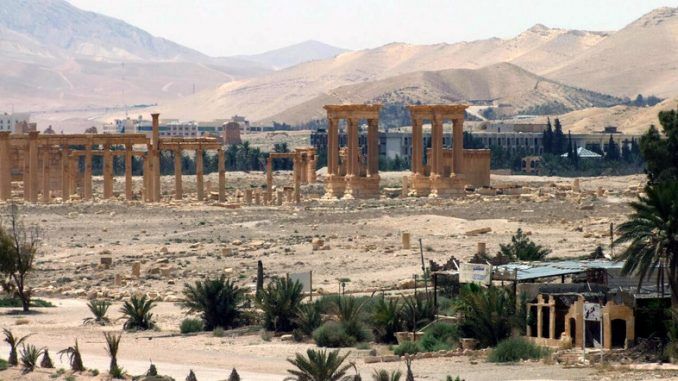
The Syrian army with the help of Russian air support is just four kilometers (2.5 miles) away from the gates of Palmyra.
The ancient city was considered the crossroads of the old world and an oasis in the Syrian desert.
Middle East Online reports:
Troops and allied militia backed by Russian air power have since early March been pushing an advance around the UNESCO World Heritage Site known as the “Pearl of the Desert”.

BYPASS THE CENSORS
Sign up to get unfiltered news delivered straight to your inbox.
You can unsubscribe any time. By subscribing you agree to our Terms of Use
They are now just four kilometres (2.5 miles) from the gates of the city that fell to the jihadists in May last year, sending shock waves around the world.
According to the Syrian Observatory for Human Rights monitor, the advance has been “slow” despite some 800 air strikes by Russia and the Syrian regime this month alone.
Last week, the army recaptured a strategic hill at the southwestern entrance of Palmyra, four kilometres from the city.
ISIS has fiercely resisted the advance, killing at least 26 pro-government fighters on Monday, the Observatory said.
Aamaq, an ISIS-linked website, claimed that 30 troops were killed in an attack by a jihadist suicide bomber.
“Meanwhile, warplanes believed to be Russian struck parts of Palmyra city and its surroundings in the east of Homs province, as well as Al-Qaryatain in the southeast,” the Observatory said.
“The battle for Palmyra is decisive for the regime, as it paves the way for the recapture of the desert area all the way up to the eastern border with Iraq,” Observatory director Rami Abdel Rahman said.
“IS would automatically lose the desert stretching from Palmyra to the Iraqi border — in other words, 30,000 square kilometres (12,000 square miles),” he added.
That would cut ISIS’s area of control from some 40 percent of Syrian territory to 30 percent, the Observatory said, adding that jihadists could then be pushed across the border into Iraq.
Thomas Pierret, a Syria expert at the University of Edinburgh, said he doubted that the army would be able to advance much further beyond Palmyra, however.
“Let’s not forget that whatever its advances in Palmyra, the regime is still fighting very difficult battles against ISIS in the desert west of Palmyra, in the eastern parts of the provinces of Homs and Hama,” he said.
But recapturing Palmyra would still be an important regime victory.
“Symbolically it would be huge, since it would enable the regime to portray itself as the protector of Palmyra’s antique ruins, even if this comes at the price of turning the modern, inhabited part of the city into rubble,” Pierret said.
Should the Syrian army retake Palmyra, that would also “help pro- (President Bashar al-) Assad lobbying in the West, which in the medium/long-term could be a game changer,” he said.
Since ISIS captured Palmyra, the city has become practically deserted after most civilians took flight.
Images recently distributed by the Observatory purported to show residential areas of the city in ruins after months of air strikes.
“The regime has adopted a scorched earth policy, and is trying to advance on several sides of the city,” said the Palmyra News Network, which is run by local activists.
Some families that had remained were now fleeing towards the Jordan border, fearing for their lives, the group said.
Global concern for Palmyra’s magnificent ancient ruins spiked in September 2015, when satellite images confirmed that ISIS had demolished the famed Temple of Bel as part of its campaign to destroy pre-Islamic monuments it considers idolatrous.
The jihadists have waged a sustained campaign of destruction against heritage sites in areas it controls in Syria and Iraq, and in mid-August last year beheaded the city’s 82-year-old former antiquities chief.
Edmondo Burr
CEO
Assistant Editor
Latest posts by Edmondo Burr (see all)
- Police Arrest Suspect In Supermarket Baby Food Poisoning - October 1, 2017
- Seoul Secures Data From Electromagnetic Interference By N Korea - September 30, 2017
- The ‘World’s First Internet War’ Has Begun: Julian Assange - September 30, 2017


Be the first to comment